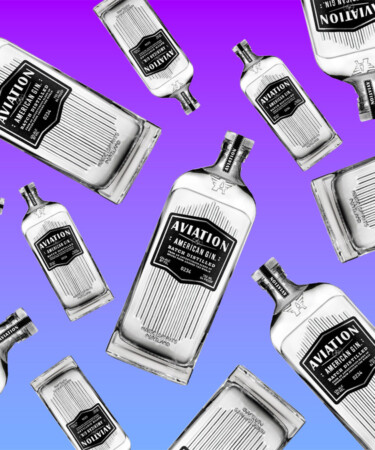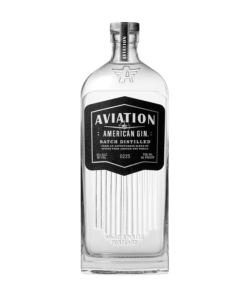The United Kingdom has a strong claim as the world’s gin capital. The Dutch may have originated the spirit when they created genever, but the English people’s love for the stuff brought the juniper-infused liquor to new levels. But in recent decades, a host of new exciting gin destinations have emerged, including the good old U.S.A. One pivotal player in the spirit’s stateside evolution: Aviation American Gin, a homegrown brand that found celebrity fame.
Founded in 2006 at Portland, Ore.’s House Spirits Distillery, Aviation Gin is the brainchild of distillery co-founder Christian Krogstad and bartender Ryan Magarian. Soon after its launch, the brand garnered a following within the trade for its more diverse, less juniper-dominated botanic profile. But in 2018, the brand truly took off in the national spotlight thanks to involvement from actor Ryan Reynolds.
Now owned by Diageo, Aviation is one of the fastest-growing gin brands in the U.S., growing by over 38 percent in volume from 2020 to 2022. Now that you know the basics, here are seven more things you should know about Aviation American Gin.
-
The spirit was originally a placeholder for whiskey.
When Krogstad founded House Spirits Distillery with Lee Medoff in 2004, the intention was to produce whiskey. As whiskey needs several years to age before it can be sold, the co-founders knew that they would need a product to sell in the interim. Originally, this product was a 100- percent rye vodka inspired by Medoff’s Russian heritage, but the two also wanted to produce a gin that was distinctive from others coming from the European distillers that were dominating the industry. The distillery then joined forces with bartender Ryan Magarian to formulate Aviation American Gin. The money generated from the gin’s sales was then used to produce Westward Whiskey, which is “brewed like a craft ale, distilled like a Single Malt, and aged like a bourbon,” according to the brand. When Aviation was sold to Davos Brands in November 2016, the money from the sale allowed for House Spirits Distillery to upgrade Westward from small-batch production and become the distillery’s largest product.
-
Aviation Gin was the result of one of the first bartender-distillery collaborations in the industry.
Magarian’s involvement in the brand came about somewhat organically: In its early years, House Spirits Distillery produced a “summer gin” at the request of a local Portland restaurateur. In summer 2005, Magarian was introduced to that spirit at a friend’s house during a party and was immediately hooked. Not long after, Magarian was introduced to the distillery’s team, and he agreed to help formulate the recipe for Aviation, which launched in 2006. The gin was designed to speak directly to bartenders like Magarian, who were seeking a gin that would shine in cocktails without the need for other ingredients to mask its taste. While bartender-distillery collaborations are fairly common in the modern spirits landscape — Fords Gin is a well-known example — the partnership between Magarian and House Spirits Distillery was the first of its kind. Since the brand’s founding, it has continued to uplift the bartending community. For example, in 2020, the brand donated $15,000 and an additional 30 percent of online sales to the United States Bartenders’ Guild to offer financial support to those impacted by Covid-19. The next year, Aviation Gin — along with Deleón Tequila and Haig Club Whisky — donated a total of $1 million to U.S. hospitality non-profit Another Round, Another Rally; Bartender’s Benevolent Fund, a Canadian non-profit; and The Drinks Trust, a U.K.-based drinks and hospitality charity.
-
It’s named after the classic pre-Prohibition cocktail.
When Aviation Gin was formulated in the early 2000s, the Aviation cocktail — made with gin, Maraschino liqueur, lemon juice, crème de violette, and simple syrup — was a popular bartender’s handshake. As the gin brand was designed to be used by bartenders, the co-founders used the cocktail’s name to play into its hospitality-adjacent reputation.
-
There are seven botanicals used in the recipe.
Aviation’s co-founders knew they wanted their formula to be distinct from styles of gin dominating at the time: London Dry and Navy Strength. In both of these styles, juniper is the dominant botanical. Rather than giving the berry center stage, Aviation highlights the seven botanicals in its blend in “just about” equal proportions: cardamom, coriander, French lavender, anise seed, sarsaparilla, fresh and dried orange peels, and, of course, juniper. Considering gin needs to have a clear juniper influence in order to be classified as such in the U.S., the latter botanical still accounts for the largest percentage of the botanical profile — but it exists in much more harmony, allowing for the full bouquet to shine through.
-
The brand created the New Western Dry style of gin.
As Aviation’s formulation didn’t adhere to gin’s prominent styles, there was no existing vocabulary to describe the new method of production — so they created it. In the 2009 essay “New Western Style Gin Defined,” Magarian outlined the criteria for the new style of gin, which is defined by a full botanical bouquet rather than overly pronounced juniper. As is the case with London Dry gin, the New Western Dry title doesn’t mean the style’s production is restricted to a specific geographical area; a New Western Dry gin can be made anywhere, not just the Wwest Coast.
“These distillers are creating gins with a shift away from the usually overabundant focus on juniper, to the supporting botanicals, allowing them to ‘just about’ share center stage,” Magarian writes in the essay. “While the juniper must remain dominant in all dry gins to achieve definition, these gins are most certainly defined, not by the juniper itself, but by the careful inclusion and balance of the supporting flavors.”
While Aviation was the first to label its gin as a New Western Dry, Magarian points to several brands predating Aviation that would fall within the style, including Tanqueray No. Ten, Hendrick’s, and Bluecoat.
-
Most of the spirit’s national success came from its former celebrity co-owner.
Aviation received a huge boost in popularity in the late 2010s thanks to its once-owner Reynolds, who acquired a majority stake in the brand in February 2018. The “Deadpool” star’s ownership infused the brand’s marketing with a sense of humor that’s proven to be incredibly fruitful: In 2019, Aviation Gin’s sales increased by over 100 percent in volume, making it one of the fastest-growing gin brands in the U.S. That same year, the brand contributed 40 percent to the growth of the super-premium gin category. In 2020, after just two years of ownership, Aviation and the entirety of the Davos Brands’ portfolio was sold to Diageo in an approximately $610 million dollar deal. Still, Reynolds has remained a key fixture of the brand’s marketing, and retains an “ongoing ownership interest,” according to Diageo.
-
Every batch of Aviation is still made in Portland, Ore.
Since Aviation’s early aughts founding, each bottle of gin has been produced in its West Coast hometown. After the brand was purchased by Davos Brands, the team at House Spirits Distillery continued to produce the stuff, hired by the new owner as a contract distiller. When Diageo purchased Aviation in 2020, they finally made plans to open a new Aviation distillery: The Aviation American Gin Distillery and Visitor Center, which opened in Portland in 2022 after almost three years of construction. The 33,000-square-foot facility, which has been described as a “Disneyland for adults” by Reynolds, was designed to be an interactive experience and includes a tasting room, a cocktail bar, and an office space for the actor that doubles as an escape room.

